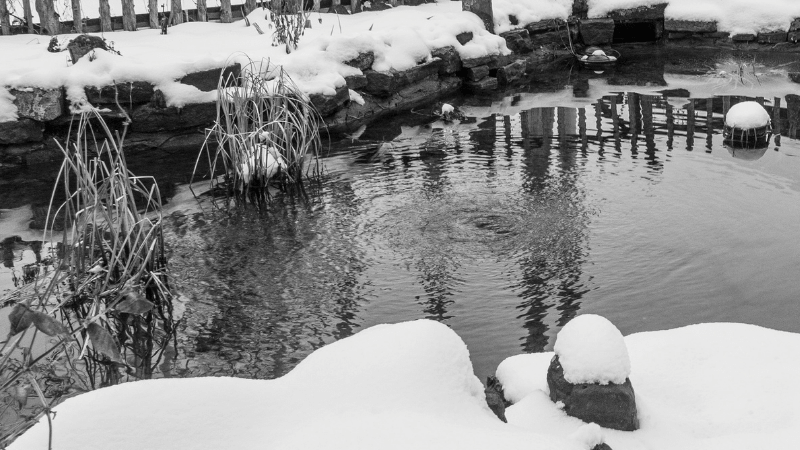How to Heat a Pond in Winter (With and Without Electricity)
Pond Academy is reader-supported. Buying through links on our site may earn us an affiliate commission. As an Amazon Associate I earn from qualifying purchases.
Depending on your location and the type of pond you have, you might need to heat the pond's water during the cold winter months.
Or, at the very least, use a heater to keep a hole in the icy surface.
So, let's learn how to heat a pond in winter with and without electricity.
But, first, let's find out if you even need to...
Should I Heat My Pond in Winter?

Heating a pond in winter can be very costly, and in many cases, is not needed. So, before I cover how to heat a pond, I want you to look closely at whether you even should.
Simply put, if you do not have any fish living in your pond, there is no need to heat it or keep a hole in the ice. Even if you do have a few pond fish, you could relocate them indoors and take them back outside again when conditions are right. Same with any pond plants you want to survive winter.
Your location is also important to take into account. If your fish pond rarely freezes over during winter (maybe one or two times for only a day or two at a time), then you still might not need to heat your pond.
Fish can endure a few days in an iced-over pond if you have properly winterized it.
And if the pond's surface does freeze over, pour some warm water over it to create a hole in the surface to allow for proper gas exchange.
Also, keep in mind, trying to heat an entire pond is a costly endeavor. Why? Because most ponds are not insulated, so the cold ground will quickly pull out any heat you put in the pond. To make up for this, you'll need a high-output heater to keep the pond water warm, which isn't cheap by most standards.
Take, for example, an inline electric pond heater, which is used to heat an entire pond. As a general rule, to raise the temperature of a 1,000-gallon pond by 10° F, you'll need a 1,000-watt heater. That equates to roughly $90 per month (if run 24 hours per day at a kilowatt-hour cost of 12 cents).
So, you can see how that could scale pretty quickly with a larger pond and/or if you needed to raise it to a higher temperature. A 5,000-gallon pond raised 20° F would cost almost $900 per month!
And in most cases, especially for backyard pond or water garden owners, it's just not needed. Remember, like koi and goldfish, most pond fish are cold-blooded and don't need warm water. They will do just fine living underneath the ice (as long as there's a hole in the ice, which we do recommend a de-icer for this purpose) over winter. They enter a period of torpor during this time, meaning they slow down and stop eating, which helps them survive during winter.
To put it in simple terms, unless your pond contains fish or other life that require warm water temperatures or proper gas exchange for survival, you most likely don't need to heat it.
With all that said, there are instances where you might want to heat the water in your pond. A few that come to mind are:
- Koi Farms: If you run or plan to run a koi farm, you might want to provide an even temperature all year round so you can feed the fish all 12 months out of the year, potentially resulting in faster-growing, larger koi carp (which means more money).
- Warm-blooded Fish Owners: Some warm-blooded fish like the Tiger Oscar or African Cichlid, etc., require warmer water to live in. So, those who don't want to house their fish indoors in a stock tank or aquarium when the water temperature drops need to use a pond heater.
- Expensive Fish Owners: If you spent $1,000 or more on your fish, for example, you might want to keep an eye on it throughout the winter months instead of hoping it's fine under the thick ice. A pond heater would help you do just that.
Those are just a few reasons you might want or need to keep your pond water warm year-round. And you may have your own reasons, as well.
So, let's now look at a few different options to help us effectively heat a pond in winter.
Get Our Best Pond Tips Sent to Your Inbox for Free!
Join thousands of others and learn from our decades of pond building and maintenance experience! Your pond will thank you!
By subscribing you agree to receive emails from PondAcademy.com. We will always respect your privacy and you can unsubscribe at any time.
How to Heat a Pond in Winter
![]() IMPORTANT
IMPORTANT
No matter which type of pond heater or de-icer you use, be sure it does not contain any copper that will contact the water, especially if you have fish in your pond. Copper toxicity can be fatal to your fish.
Pond De-Icer
The most common water heating solution for a pond is a de-icer. A de-icer works by floating in your pond and keeping a hole open on the icy surface. This allows for proper gas exchange by allowing oxygen into your pond and harmful gases to escape.
A pond de-icer doesn't heat an entire pond's water or maintain it at a set temperature like some of the options below. However, as mentioned above, most pond fish can live well under the ice in a pond as long there's a hole in the icy surface.
Submersible Pond Heater
A submersible pond heater is a great way to create "pockets" of heated water for small to medium-sized ponds.
While submersible pond heaters won't typically heat your entire pond (unless it's really small or you use multiple heaters), they will provide a nice warm area for your fish to hang out during winter.
I recommend submerging the heater in the deepest part of your pond and where there isn't much circulating water. This will help prevent losing heat to the surface.
Pond Heat Exchanger
Pond heat exchangers are one of the more cost-effective methods of controlling the temperature of an entire pond. There's a higher upfront cost, but the average monthly costs are more economical than most other methods.
The way a gas pond heat exchanger works is, pond water enters through an inlet on the exchanger and flows past a coil containing hot water from the boiler. The heat generated from the hot water in the coil is transferred to the pond water that flows around it, effectively heating your pond.
Pond Heat Pump
Heat pumps are another cost-effective way to heat an entire pond. And with some models, they can even cool water, as well, in the Summer months.
This type of pond heater is less harmful to the environment since 80% of the energy required to heat your pond is collected from outside air!
When buying a heat pump, make sure it's designed for pond use and cold-weather application.
Inline Electric Pond Heater
Inline electric pond heaters are the most common way to heat an entire pond since their upfront cost is one of the lowest. However, as we learned above, the running costs of this type of electric heater, especially for a large pond, can be extremely high.
So, how do they work? Pond water is pumped in and through a heating chamber (with a heating element), where it is heated and then returned to the pond. They are typically installed right after your pond pump in the pond's plumbing system. Continually cycling water through this heater will eventually increase the temperature of your pond.
![]() IMPORTANT
IMPORTANT
Your fish will require more food and oxygen once the water is heated and the pond water temperature rises. It is vital to monitor the levels of dissolved oxygen which need to be kept above a minimum of 6 mg per liter for health reasons. I recommend running a pond aerator alongside a heater to ensure the fish's oxygen requirements are met.
How Can I Heat My Pond Without Electricity?
As we learned, running a pond heater can incur some serious running costs. This is why many pond owners are looking for cost-effective ways to keep their ponds warm in the winter months.
I completely get it. But, you need to be realistic with your expectations. Especially if you live in zones where it gets extremely frigid in Winter. If this is you, I personally wouldn't rely on any of these methods by themselves if you really care about the health of your fish. But, used in conjunction with one of the methods above, you might be able to save a little money.
For warmer climate zones, you might be able to get away with one of these methods alone. I cover this more in-depth in our guide on how to keep a pond from freezing without electricity.
To heat a pond for free or for cheap without using electricity, you have a few options:
Solar Pond Heater
Typically, solar-powered water heaters are used to heat swimming pools. But, they could definitely be used to help raise the temperature of the water in your pond, as well.
This type of heater works by circulating your pond water through solar panels, which then uses the sun's energy to heat the water and returning it to your pond.
I must mention, though, that unless you have a solar pump, as well, you will still be using a small amount of electricity to pump the water to your solar heater and back into your pond.
Plus, you'll only be circulating warm water to your pond during the daytime, so at night your pond's temperature will drop, maybe drastically, if you live in a frigid area.
I would like to see somebody with a little ingenuity make this setup work, though, so if you try it out and it works, please let me know!
Winter Pond Cover
A pond cover won't technically heat your pond, but it will help keep the cold out, so the water temperature will stay a few degrees warmer and may even prevent the pond from icing over (depending on your location and how cold your Winter's get).
Plus, you get the added benefit of blocking leaves and other debris from blowing into your pond during the winter months, making Spring cleanup that much easier.
If you can't find an actual pond cover designed for Winter use, using a rigid dome pond cover (helpful if you get a lot of heavy snow) with a couple of insulated tarps over it is a good DIY option.
Solar Pond Aerator
If merely keeping a hole in the icy surface is all you need to do, and you live in a milder climate zone, you might be able to get away with a solar pond aerator.
Plus, their running costs are about 1/10th that of an electric pond heater.
Of course, the downside is that unless you have a battery backup installed on your solar aerator, it won’t run at night (when your pond is likely to freeze over). So, be sure to get a model with a battery backup and check on your pond often to make sure the aerator is keeping up.
Learn how to aerate a pond without electricity for more information.









